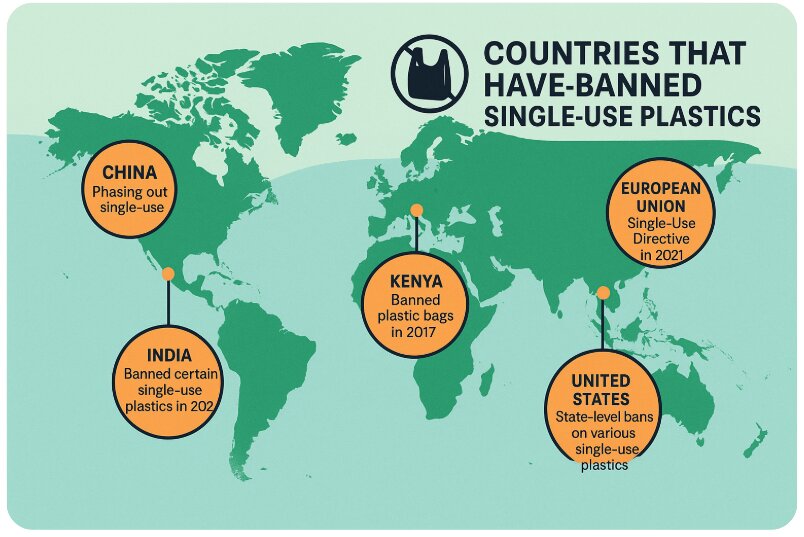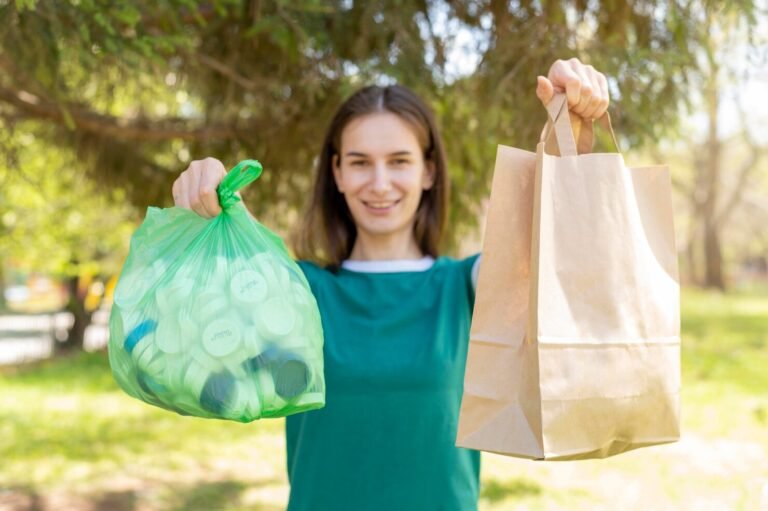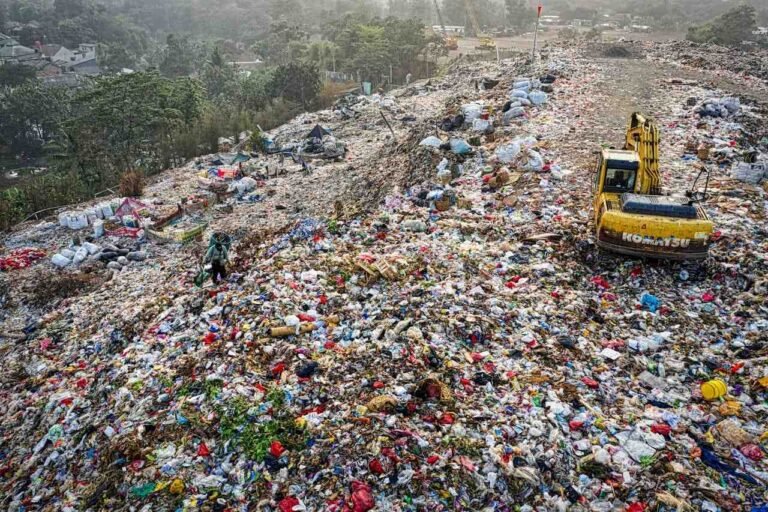Countries That Have Banned Single-Use Plastics
It’s becoming impossible to ignore the damage caused by single-use plastics (SUPs). What once seemed like a convenient solution has turned into a global crisis affecting our oceans, wildlife, and even our own health.
Back in 2015, Dr. Jenna Jambeck, an environmental engineer, revealed that approximately 8 million metric tons of plastic waste enter the oceans annually. To put that into perspective, it’s like dumping five grocery bags filled with plastic on every foot of coastline around the world each year.
The situation is worsening. A 2020 study by Pew Charitable Trusts and SYSTEMIQ projected that, without significant intervention, the annual flow of plastics into the ocean could nearly triple by 2040. This means that, in less than two decades, the amount of plastic entering our oceans each year could reach 29 million metric tons.
The impact of plastic pollution isn’t limited to the environment. Recent studies have found microplastics in human blood, with particles detected in nearly 80% of the people tested. Microplastics have also been discovered in human placentas, raising concerns about potential effects on fetal development.
These findings highlight the urgent need to address plastic pollution. While the challenge is immense, it’s not insurmountable. The same 2020 study by Pew Charitable Trusts and SYSTEMIQ suggests that immediate and sustained action could reduce the annual flow of plastic into the ocean by more than 80% using existing technologies.
Efforts are already underway. Governments are implementing bans on certain single-use plastics, and communities are organising clean-up initiatives. These actions demonstrate a growing recognition of the problem and a collective willingness to find solutions.

In This Article
- Africa
- Asia
- Europe
- North America
- Central America and the Caribbean
- Oceania
- Middle East
- What We’ve Learned: Real Impacts and Global Shifts
- Final Thoughts: What You Can Do
Africa
Kenya
In 2017, Kenya made headlines by enforcing one of the world’s strictest bans on plastic bags. The law prohibited the manufacture, sale, and use of plastic carrier bags, imposing penalties of up to $38,000 in fines or four years in prison for violators.
Initially, the ban faced resistance. Many Kenyans were accustomed to the convenience of plastic bags, and the transition posed challenges for both consumers and businesses. However, over time, the impact became evident. Streets that were once littered with plastic waste began to clear, and the environment showed signs of recovery. Reports indicated that abattoirs found fewer plastic bags in the stomachs of livestock, a significant improvement from previous years.
Despite these successes, challenges remain. Some traders continue to use banned plastic bags, often smuggled from neighbouring countries like Uganda and Somalia. Enforcement varies, with some offenders facing fines or jail time, while others receive warnings. Nevertheless, Kenya’s bold move has set a precedent in Africa, demonstrating the potential for impactful environmental policies.
Nigeria
In 2019, Nigeria’s House of Representatives passed a bill to ban plastic bags, signalling the country’s intent to combat environmental waste. While full enforcement is still being rolled out, cities like Lagos have seen increasing public awareness through campaigns and education.
Plastic waste remains a major concern in Nigeria, especially in urban centres where blocked drainage contributes to flooding. However, the government and NGOs are working together to provide alternatives, such as biodegradable packaging and cloth bags. The key challenge remains implementation—without strict penalties or consistent monitoring, many vendors still rely on plastic. But momentum is growing, and each awareness drive brings more people on board.
Zimbabwe
In 2017, Zimbabwe took a firm stance by banning expanded polystyrene (EPS), locally called “kaylite.” This type of packaging, often used for takeaway food, is known for being non-biodegradable and releasing toxic chemicals when burned. The Environmental Management Agency (EMA) enforced the ban with fines ranging from $30 to $500.
As of April 2025, the ban is still in place. While some businesses initially pushed back, fearing increased costs, many have transitioned to paper, cardboard, or biodegradable alternatives. In markets across Harare, you’ll now find vendors wrapping food in compostable materials. The EMA continues to run public education efforts, and according to local reports, the ban has led to visibly cleaner streets and waterways.
Zimbabwe’s stand shows that long-term commitment can pay off. By sticking to the ban, despite challenges, the country is making a real environmental impact—one takeaway container at a time.
Asia
China
In 2020, China embarked on an ambitious journey to phase out single-use plastics by 2025. The government’s plan targets non-biodegradable plastic bags, straws, and other disposable items, aiming to reduce plastic pollution significantly. Major cities have already implemented bans on non-biodegradable plastic bags in supermarkets and shopping malls, with the scope expanding nationwide by 2025.
E-commerce giants like Alibaba have responded by adopting biodegradable packaging materials, aligning with the government’s environmental goals. This shift not only addresses environmental concerns but also sets a precedent for sustainable practices in the industry.
India
On July 1, 2022, India implemented a nationwide ban on 19 single-use plastic items, including straws, cutlery, and packaging films. This move aims to curb plastic pollution and promote sustainable alternatives. The Indian Institute of Packaging has reported a significant increase in demand for eco-friendly alternatives, indicating a positive shift towards sustainability.
The ban’s implementation varies across states, with some regions facing challenges in enforcement. However, the overall direction points towards a more sustainable future, with increased awareness and adoption of eco-friendly practices.
Japan
Japan has taken a measured approach to reducing plastic waste. Since April 2022, businesses have been required to minimise the use of 12 types of single-use plastic items, including cutlery and straws. Many convenience stores have started offering alternatives like bamboo cutlery, encouraging consumers to make environmentally conscious choices.
Retailers are also beginning to charge for plastic utensils and straws, incentivising customers to bring their own or opt for sustainable options. This gradual shift reflects Japan’s commitment to environmental responsibility while considering consumer habits.
Taiwan:
Taiwan’s 2018 plan aims to eliminate single-use plastics by 2030. The phased approach includes restrictions on plastic straws, bags, utensils, and cups, with incentives for consumers who bring reusable containers.
Cafes and retailers are participating by offering discounts to customers who opt for sustainable options, fostering a culture of environmental responsibility. The government’s comprehensive strategy reflects a strong commitment to reducing plastic waste and promoting sustainability.
Europe
European Union
In July 2021, the European Union implemented the Single-Use Plastics Directive, banning items such as plastic cutlery, plates, straws, balloon sticks, and cotton bud sticks across all member states. Additionally, cups and food containers made of expanded polystyrene (EPS) and all products made of oxo-degradable plastic were also prohibited.
This directive has led to tangible environmental benefits. A report from the European Commission in February 2025 indicated a 29% reduction in marine macro litter along the EU coastline between 2015–2016 and 2020–2021.
France
France is leading the charge in reducing plastic waste. The country first prohibited single-use plastic bags in 2015, and by 2020, the restrictions expanded to cover items like plastic cups, plates, and utensils. Through its AGEC law (Anti-Waste for a Circular Economy), France has committed to eliminating all single-use plastic packaging by 2040.
On top of legislation, practical innovations are making a real difference. Many grocery stores now offer refill stations, giving shoppers the option to buy essentials without unnecessary packaging. And as of January 2023, sit-down restaurants with 20 or more seats must serve food and drinks in reusable containers, helping reduce waste even further.
Germany
Germany implemented a ban on lightweight plastic bags (those with a wall thickness below 50 microns) at points of sale starting January 1, 2022. This measure complements the EU’s directive and reflects Germany’s commitment to reducing plastic waste.
In addition, many German bakeries have adopted environmentally friendly practices by providing paper bags with edible starch liners, offering customers a sustainable alternative to traditional plastic packaging.
United Kingdom
In October 2023, England implemented a ban targeting several single-use plastic products, such as cutlery, plates, bowls, trays, balloon sticks, and some polystyrene food containers and cups. However, this regulation makes exceptions for items like plates and trays when they’re used as packaging for pre-packaged food sold directly on shelves.
Despite this progress, environmental groups are urging the government to go further. They’re calling for stricter and wider-reaching bans to cover more plastic items and better tackle the growing issue of plastic pollution.
North America
Canada
As of December 20, 2022, Canada prohibited the manufacture and import of several single-use plastic items, including checkout bags, cutlery, certain foodservice ware, stir sticks, and straws. The sale of these items was banned a year later, on December 20, 2023. Looking ahead, the manufacture, import, and sale for export of these plastics will be prohibited by December 20, 2025.
This phased approach aims to eliminate over 1.3 million tonnes of hard-to-recycle plastic waste and more than 22,000 tonnes of plastic pollution over the next decade. The regulations focus on items that are prevalent in the environment, harmful to wildlife, and have readily available alternatives.
United States
In the United States, the approach to single-use plastics varies widely across states and municipalities. California has been at the forefront, with a new law signed in September 2024 that bans all plastic shopping bags at grocery stores, effective from 2026. This move builds upon earlier legislation that had already prohibited thin plastic bags.
Other states, including New York, have implemented their own bans on single-use plastic items. In Seattle, businesses have embraced compostable alternatives, spurred by local ordinances and consumer demand. The city’s ban on non-compostable disposable straws, implemented in July 2018, is one example of such initiatives.
These state and local efforts reflect a growing recognition of the need to address plastic pollution, even in the absence of comprehensive federal policies.
Mexico
Mexico has also made strides in reducing plastic waste. Mexico City implemented a ban on single-use plastic bags starting January 1, 2020, with businesses facing fines for non-compliance. In Oaxaca, local entrepreneurs have turned to traditional methods, using banana leaves as packaging for food items, offering an eco-friendly alternative to Styrofoam.
Central America and the Caribbean
Jamaica
In 2019, Jamaica took a bold step to protect its environment by initiating a phased ban on single-use plastics, including the ubiquitous “scandal bags,” plastic straws, and polystyrene containers. This comprehensive ban, fully enforced by 2021, aimed to curb the influx of plastic waste that often clogs waterways and harms marine life.
To support this transition, local NGOs and community groups actively distributed reusable cloth bags in schools and churches, fostering a culture of sustainability from the grassroots level. The National Environment and Planning Agency (NEPA) played a pivotal role in enforcing the ban, prosecuting over 50 entities for non-compliance by 2023.
While challenges persist, especially in informal markets where banned plastics occasionally resurface, the impact is evident. A 2022 study revealed that banned items now constitute only 0.03% of plastics in waste disposal facilities, indicating significant progress.
Panama
In July 2019, Panama made history as the first country in Central America to ban single-use plastic bags. The move was driven by growing concerns over plastic waste piling up on beaches and in waterways. Under the new law, businesses such as supermarkets, pharmacies, and retail shops were required to stop offering conventional polyethene plastic bags to customers. Wholesale businesses were given a bit more time, with a compliance deadline set for 2020.
The ban was part of a broader initiative to reduce plastic waste and its detrimental effects on marine ecosystems. Public awareness campaigns, featuring slogans like “less bags, more life,” were launched to educate citizens on the importance of the ban and encourage the adoption of reusable alternatives.
While comprehensive data on the ban’s impact is limited, the initiative marked a significant step towards environmental sustainability in the region. Panama’s proactive approach has set a precedent for neighbouring countries to follow in combating plastic pollution.
Oceania
Australia
Australia’s journey began in 2003 when Coles Bay in Tasmania became the first town to ban plastic bags. By 2022, all states and territories had prohibited lightweight plastic bags under 35 microns thick. Major supermarkets like Coles and Woolworths played a pivotal role by removing free plastic bags and introducing reusable alternatives. This initiative led to an estimated 80% reduction in plastic bag usage nationwide, preventing approximately 1.5 billion bags from polluting the environment.
New Zealand
New Zealand began its fight against plastic pollution by banning plastic bags in 2019. The government expanded these efforts in 2022 to include items like cotton buds, drink stirrers, and certain polystyrene food packaging. By July 2023, further bans encompassed single-use plastic produce bags, cutlery, plates, and bowls. These measures have successfully removed nearly one billion plastic items from circulation, significantly reducing environmental waste.
Vanuatu
Small but mighty, Vanuatu set an early example in 2018 when it became one of the first countries to ban single-use plastic bags, straws, and polystyrene containers. This initiative led to a remarkable decrease in plastic waste, with such items dropping from 35% to less than 2% of the nation’s waste. The ban also revitalised traditional crafts, as local artisans began weaving biodegradable bags from pandanus leaves, providing sustainable alternatives and new income opportunities.
Middle East
United Arab Emirates
In a significant move towards sustainability, the United Arab Emirates commenced a nationwide ban on single-use plastic shopping bags on January 1, 2024. This initiative is part of a broader, phased strategy to reduce plastic waste and promote eco-friendly alternatives. By January 1, 2026, the ban will extend to encompass plastic cups, lids, cutlery, plates, and food containers, aiming to mitigate environmental pollution and protect marine life.
Dubai, leading this environmental effort, has already implemented measures encouraging the use of paper and reusable bags in malls and supermarkets. The government is actively promoting sustainable practices, urging residents and businesses to adopt reusable products and support the circular economy. This comprehensive approach underscores the UAE’s commitment to environmental conservation and sets a precedent for other nations to follow.
What We’ve Learned: Real Impacts and Global Shifts
| Country | Year Implemented | Estimated % Reduction in Plastic Waste | Notes |
|---|---|---|---|
| Kenya | 2017 | 80% in urban areas | According to UNEP, the 2017 ban on plastic bags led to a significant reduction in plastic waste in urban regions. |
| France | 2020 | 40% nationwide | As per the Ministry of Environment, the ban on plastic cups, plates, and cutlery contributed to a substantial decrease in plastic waste. |
| Taiwan | Ongoing to 2030 | 30% reduction so far | The Environmental Protection Administration reports a 30% reduction in plastic waste as part of its phased approach to eliminate single-use plastics by 2030. |
| Canada | 2023 | Data pending | The full impact of Canada’s 2023 ban on certain single-use plastics is yet to be determined, with assessments ongoing. |
Expert Voices
For Dr. Marcus Eriksen:
As Dr. Marcus Eriksen, co-founder of the 5 Gyres Institute, has emphasized in numerous interviews and talks, bans on single-use plastics are just one part of the solution. He advocates for a shift toward circular economies, where materials are reused and waste is transformed into resources.
For Lisa Svensson (formerly of UNEP):
Lisa Svensson, former UN Environment Programme Coordinator for Marine and Coastal Ecosystems, has described plastic pollution as a “planetary crisis” and one of the most pressing environmental challenges of our time. She has noted that the global movement against single-use plastics reflects a growing and unified call for urgent international action.
Final Thoughts: What You Can Do
Tackling plastic pollution isn’t just about policies—it’s about the choices we make every day. Simple actions can lead to significant change:
- Bring your own bags: Reusable bags reduce the demand for single-use plastics.
- Say no to plastic straws and cutlery: Opt for reusable or biodegradable alternatives.
- Support sustainable businesses: Choose companies that prioritise eco-friendly packaging.
- Educate others: Share information about local bans and sustainable options.
These steps align with recommendations from environmental authorities like the U.S. Environmental Protection Agency (EPA) and the United Nations Environment Programme (UNEP).
Every small decision contributes to a larger cultural shift towards sustainability. By making conscious choices, we collectively move towards a cleaner, healthier planet.







